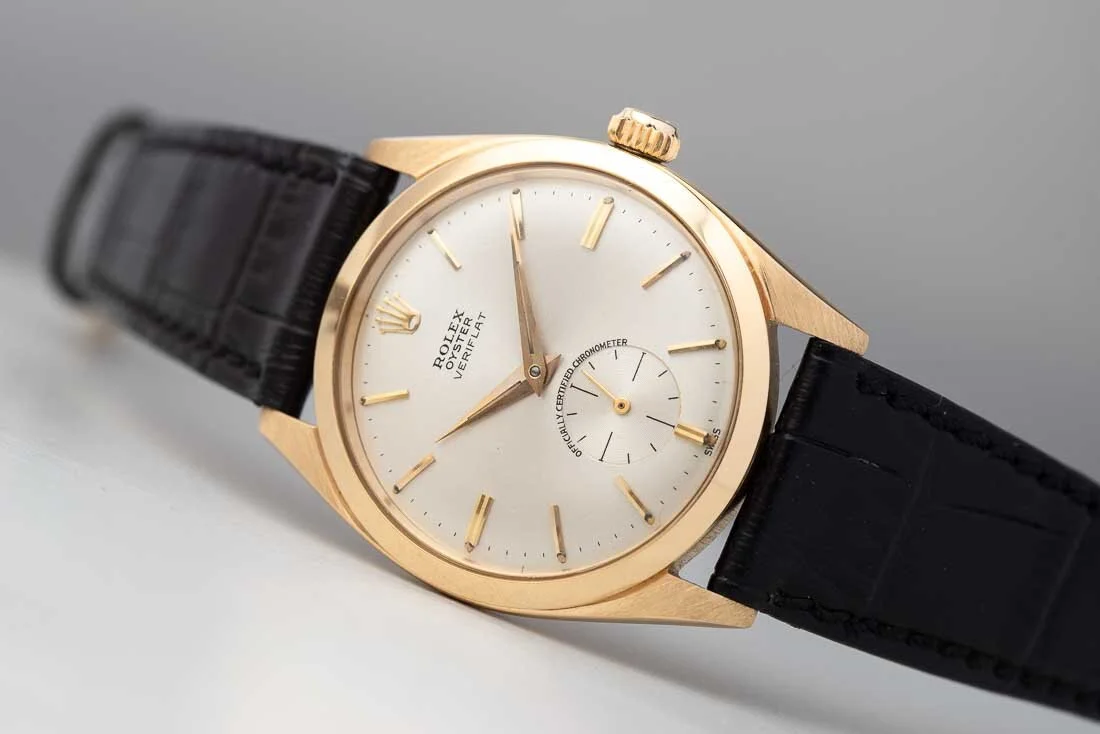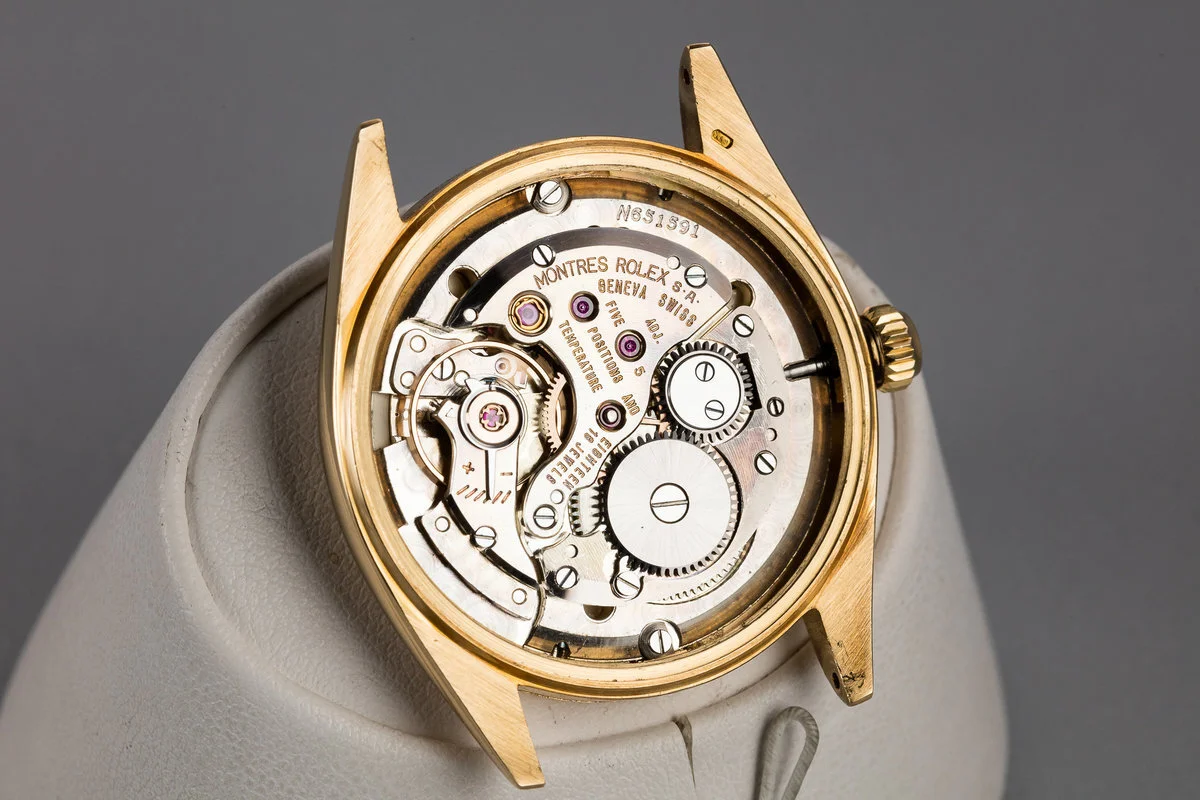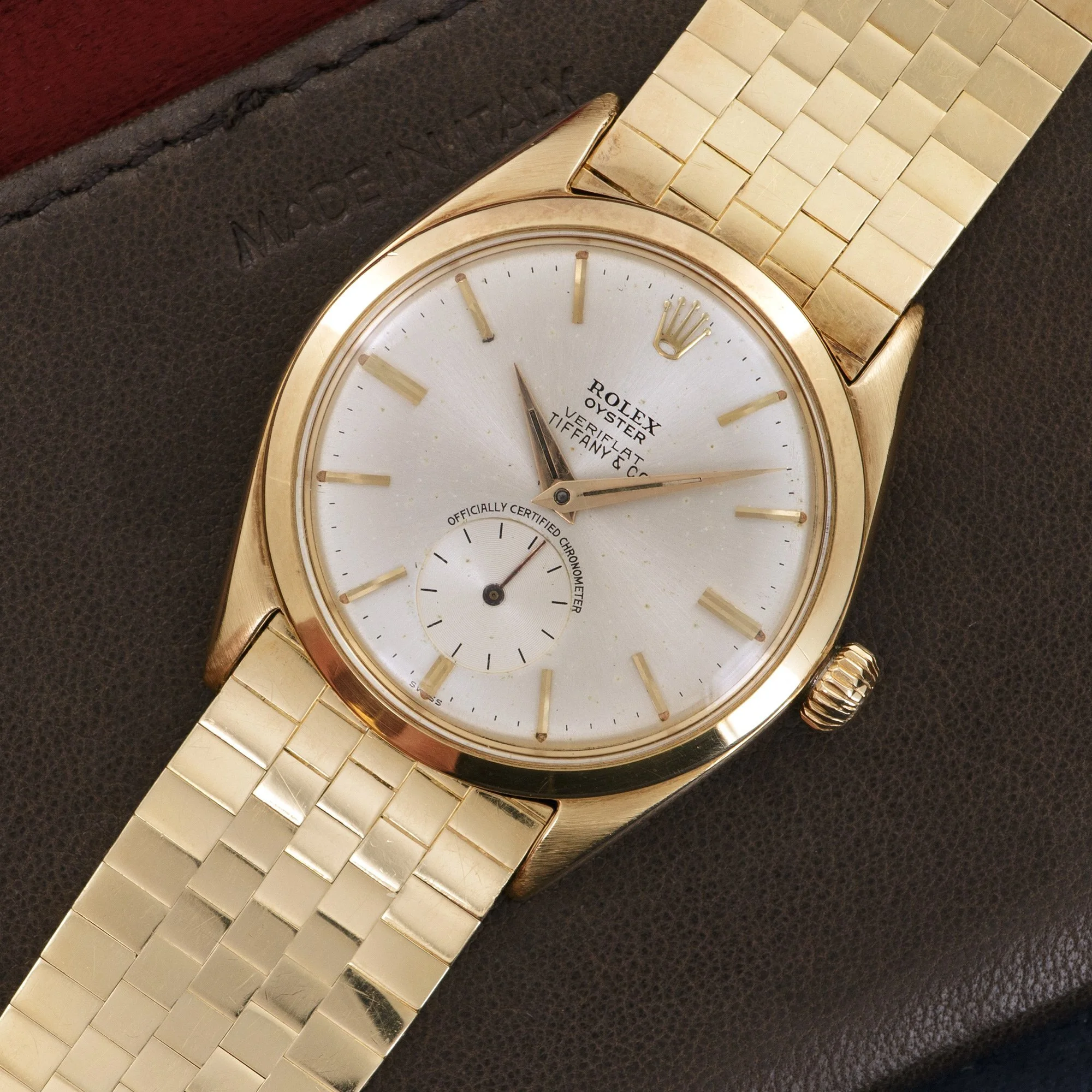An underrated and robust vintage dress watch from Rolex
When people think of 1950s Rolex, they usually think of stainless steel sports watches. After all, it was the decade the Explorer, Submariner, GMT-Master, and Milgauss all first came into production. But, it was a hugely transitional decade for Rolex too: for example, in the early 1950s it was still producing its Oyster Perpetual reference 6062 with a moon phase. A moon phase complication in a waterproof case is a bit of an historical oddity, but it exemplifies a transitional phase at Rolex: a maker of fine wristwatches that was swiftly pivoting to making practical timepieces for professionals.
What is the Rolex Ref. 6512 Veriflat?
Another 1950s Rolex that exemplifies this dichotomy is the Rolex Veriflat reference 6512. (While a watch name with a vague attempt at wit through word play might prompt the same from a writer covering such subject, I’ll resist.) It features a waterproof Oyster case, but only in pink or yellow gold, as well as other design cues that tilt decidedly towards elegance. The Rolex Veriflat was introduced in 1954 and only produced until 1962, making for a relatively short lifecycle compared to many models introduced by Rolex during the same time that remain stalwarts of the brand’s collection even to this day. Apparently, the Veriflat was the same price as an Oyster Perpetual when it was introduced, but without the benefit of an automatic movement, it didn’t sell well, thus its rarity on the vintage market.
You can almost think of the Veriflat as Rolex’s answer to Patek Phillipe’s Calatrava reference 2526. Patek launched its first automatic movement, the 12-600 AT, in 1953, 22 years after Rolex patented its self-winding movement (i.e., “perpetual”), placing it in the Ref. 2526’s tough, waterproof case (but, ever since the book was written on the Ref. 2526 a few years back, those have become nearly unattainable). It’s almost like after Patek came out with its first automatic movement, Rolex switched it up and said, “nah, we’re gonna do manual again, and we’re gonna do it super slim.” Like the Patek Ref. 2526, the Rolex Veriflat is a robust, waterproof dress watch that, due to these characteristics, stands out among similar dress watches from Piaget, Cartier, or others from the same era.
The Veriflat Ref. 6512 features a waterproof Oyster case, often thought more typical of Rolex’s sports watches (Submariner, GMT-Master, etc.). But, this Oyster case was the thinnest ever produced by Rolex, measuring just 9mm (and 34mm in diameter). To obtain this thin profile, Rolex engineered a special recessed case back so the movement could sit flat and the case could still retain its screw-down crown. Considering Rolex was still churning out Bubblebacks up to and around this time, it’s quite an accomplishment.
Additionally, it was produced in relatively low quantities and only in precious metal: examples in both yellow gold and pink gold can be found (with pink gold seemingly much more rare). The result is a thin, precious metal watch with all the charm of a classic dress watch but a slightly more robust build that customers had come to expect from Rolex.
The super slim Rolex Caliber 1000
Rolex’s slim manual-wind caliber 1000 | HQMilton
To achieve the Veriflat’s thin proportions, Rolex produced a new in-house manual winding caliber 1000. The movement was created by Rolex by taking its automatic caliber 1030 and removing the rotor. The caliber 1030 itself was Rolex’s first completely in-house movement, so it’s cool to think that once they figured out the whole in-house thing, they weren’t afraid to experiment, bringing new calibers and watches to market as a result. The caliber 1000 is an 18-jewel movement, adjusted for temperature and in five positions. It powers a subsidiary seconds at 6 o’clock, uncommon for a time-only Rolex in an Oyster case. The resulting movement measures just 3.45mm in thickness. The Veriflat is the close cousin of the Rolex Verislim reference 9164, a slightly dressier watch that also uses the caliber 1000. Around this same time, a partnership of Vacheron Constantin and Jaeger-LeCoultre introduced its caliber 1003, measuring just 1.64mm thick and taking the title of the world’s thinnest mechanical movement.
In other words, for less than the current going rate of a matte dial Submariner, you can pick up a super rare Rolex with a gold Oyster case and one of the thinnest movements the brand has ever produced — that is, if you can find one.
Veriflat dial variants
Now, for the dial. The Veriflat Ref. 6512 features a gorgeous gold-tone sunburst dial with applied gold markers and Rolex crown at 12 o’clock. “Rolex / Oyster / Veriflat” are printed in three lines of text directly beneath the crown. On most versions, the subsidiary seconds itself features crosshairs that start on the outer edge of the sub dial and point towards the small seconds hand. Above the subsidiary seconds at 6 o’clock, there will also be printed text, reading either “Precision” or “Officially Certified Chronometer”. The same caliber 1000 movement ticks inside both: “Officially Certified Chronometer” simply indicates that the watch was COSC certified.
As a general point, around the late 1950s and early 1960s, Rolex moved from printing “Officially Certified Chronometer” to printing “Superlative Chronometer / Officially Certified” on its COSC-certified movements. This is a good way to distinguish, for example, a super early gilt dial Explorer 1016 from one that’s merely early. In any event, every COSC-certified Veriflat example I’ve seen reads “Officially Certified Chronometer.”
On the Veriflat’s dial, “Officially Certified Chronometer” runs in a concentric circle around the small seconds. “Precision” is printed in a serif font that runs in either a straight line or curves around the small seconds subdial.
There are a few dial variations of the Veriflat, though with such limited information and photography available on the internet, I’m reticent to say there aren’t more original, correct variants to be found.
A common dial variant of the Rolex Veriflat | HQMilton
A Veriflat with familiar pencil hands | A Collected Man
In addition to the general features above, the most common variation of the Veriflat features dauphine hands, minute markers on the outer edge of the dial, and small lume plots topping the indices. Either “Precision” or “Officially Certified Chronometer” above the small seconds can be original and correct. The Rolex crown is typically elongated, sitting in place of the 12 o’clock marker at the top of the dial.
Instead of dauphine hands, some later examples of the Veriflat feature the baton and pencil hands more familiar from the Oyster Perpetual line.
A seemingly less common variation of the Veriflat features this same dial, but with alpha hands. In general, these look to be slightly earlier production models than the more commonly seen version with dauphine hands. The alpha hands give an even more elegant look to an already handsome watch.
A rare Veriflat with alpha hands | Christie’s
Veriflat with an inner minute track | Monaco Legends
Finally, an even more rare early-production version of the Veriflat features alpha hands and an inner minute track on the dial (as opposed to the more typical minute track that sits on the outer edge of the dial). While this dial variation typically seems to have the common stick indices, examples have also been sold that feature the dagger indices commonly used by Rolex in other models at the time.
While many examples nowadays are offered with non-original or after-market straps, some do come with the original Rolex strap. For example, the alpha hands variant above from Christie’s was offered with the original Rolex strap and buckle.
Instead of a strap, a few rare examples feature a beautiful brick bracelet. For example, one recently sold by The Keystone featured this bracelet, in addition to the covetable “Tiffany & Co.” stamp from the famous U.S. retailer, just below the “Veriflat” at 6 o’clock.
Veriflat: Very versatile
The Veriflat Ref. 6512 is a vintage Rolex model that, despite its rarity, remains largely under the radar. Sure, it’s not a stainless steel sports watch, but let’s focus on what it is: a short-production, precious metal Oyster case timepiece with a technically impressive slim movement. The modern collector loves stainless steel watches because they’re supposedly practical for modern life, transitioning seamlessly from SoulCycle to suit and tie. But, if tastes shift back towards precious metals, there’s a chance the Rolex Veriflat will be one of the first watches from Rolex’s vintage catalog to gain appreciation among collectors. It nicely bridges the gap from SoulCycle to suit: a robust Oyster case that can handle anything, but a gold case that’s decidedly not any other Rolex sports watch.
And as far as vintage dress watches go, it’s one of the most robust and practical, capable of standing up to that SoulCycle sweat in a way other vintage dress watches might not. Sure, at 34mm and just 9mm thick, it wears a little small for many modern tastes, but its aesthetic and appeal remains timeless.
Abbreviated list of sold Rolex Ref. 6512 Veriflats:
Yellow Gold Ref. 6512 Veriflat with Tiffany & Co. stamp, The Keystone (2019)
Yelow Gold Ref. 6512 Verifilat, A Collected Man (2019)
Pink Gold Ref. 6512 Verifilat, Monaco Legends (2019)
Yellow Gold Ref. 6512 Veriflat, HQMilton (2019, also appearing for sale on Rolex Forums)
Yellow Gold Ref. 6512, Luna Oyster (2018)
Yellow Gold Ref. 6512, Bonham’s (2017)
Pink Gold Ref. 6512 Veriflat, Christie’s (2013, also sold by Christie’s in 2012)
Yellow Gold Ref. 6512, Matthew Bain
Yellow Gold Ref. 6512 Veriflat, Antiquorum (2006)
Yellow Gold Ref. 6512 Veriflat, Antiquorum (2006)
Pink Gold Ref. 6512 Veriflat, Antiquorum (2006)
Yellow Gold Ref. 6512 Veriflat, Sotheby’s (2005)
Yellow Gold Ref. 6512 Verifilat, Sotheby’s (2005)
Yellow Gold Ref. 6512 Veriflat, Antiquorum (2004)
Pink Gold Ref. 6512 Verifilat, Antiquorum (1999)






